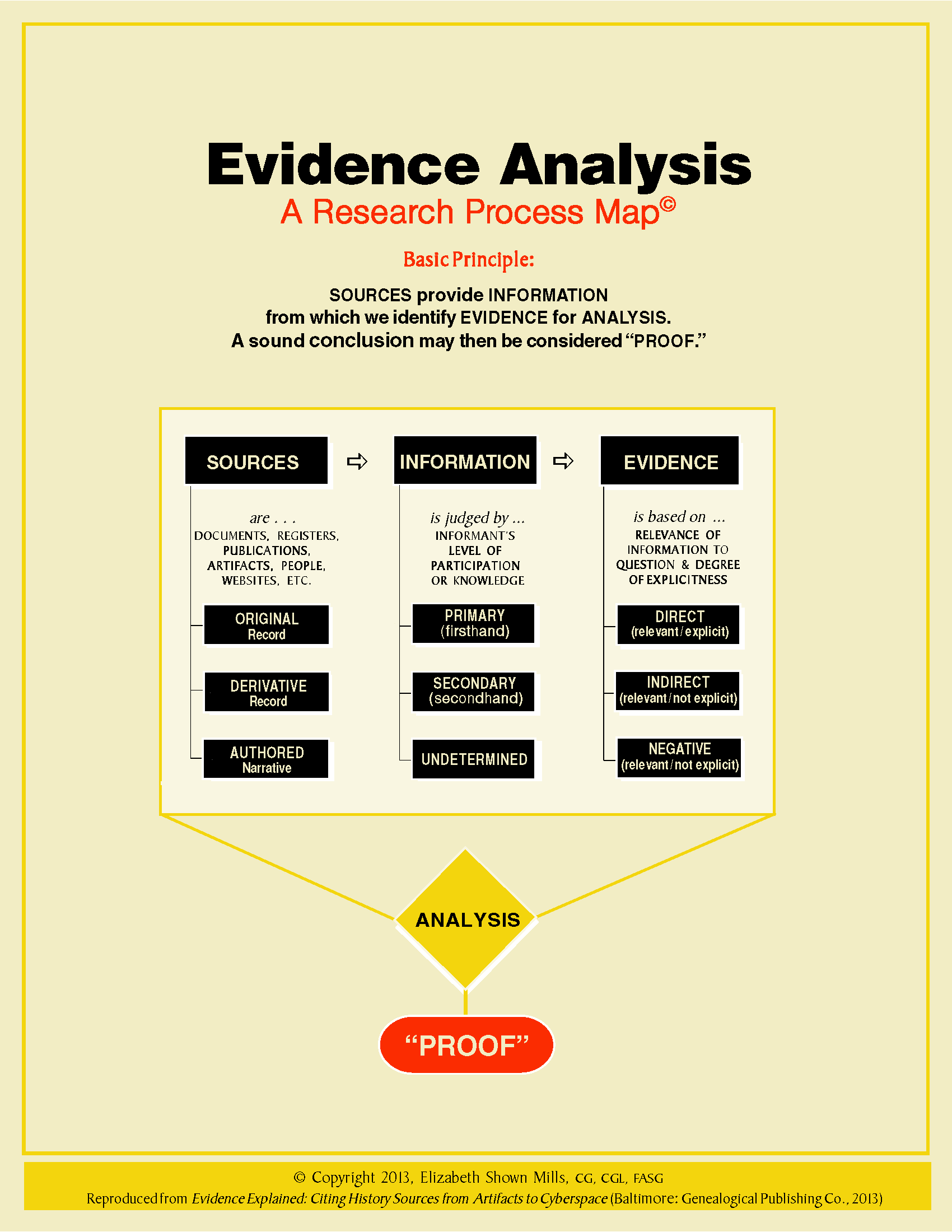Inquiring minds have asked, “About DNA and the GPS: How is DNA related as to source, information, and evidence with regard to the match and the most recent common ancestor?"
Yesterday, we tackled the first issue: separating two different tools that are often mentally merged:
- The GPS: the Genealogical Proof Standard whose five criteria are used to evaluate a conclusion. These are criteria we apply to a whole body of evidence.
- The EAM: the Evidence Analysis Map that outlines the difference between sources, information, and evidence. This is an evaluation tool we apply at the granular level, each time we “use something.”
Today, let’s consider DNA test results as source—that first path of the Evidence Analysis Map.

DOCUMENTARY SOURCES
Evaluations of sources focus upon the form of that record. Any type of source can be (1) an original record, (2) a derivative created from those originals, or (3) an authored narrative that may be based on records but represent the author’s thoughts and opinions.
Within this frame work, lines are also blurred.
Original records aren’t always “original” in the purest sense. For example:
- “Duplicate originals” were created for many censuses.
- Court clerks hand-copied or retyped deeds into their registers and then returned the “true original” to the owner. The register copy is today treated as an original because (a) it’s an official copy and (b) the “true original” is likely lost to time.
- Documents are imaged and originals may then be removed from public use. That imaging creates its own issues that have to be considered but, when done by officials or reliable entities, we view them as originals.
Derivative records are more problematic. These include materials such as
- Transcriptions (word-for-word copies) made by Joe Blow.
- Abstracts in which Winnie Whoever has picked out the pieces of information she considered useful and ignored the rest.
- Databases in which pieces of information from tens of thousands of records are keyed in, to create a new digital “source.”
Quality varies widely among derivatives, but one result is constant. Errors are made amid all that processing.
Narratives might be
- Authored articles or books.
- Research reports.
- Videos, or more.
Narratives are original in the sense that each (supposedly) is a new piece of work. But those we use for research are usually based on the study of original and derivative records. Someone has accessed, analyzed, interpreted, and correlated a body of records and presented a conclusion based on that work.
So ... how does DNA fit into this framework?
DNA SOURCES
All of the above considerations apply to DNA test results, just as they do to any other physical, visual, or oral source.
DNA test results are wonderful sources, but they’re not an exceptional source. They’re not a type into itself. They don’t even come in just one type. They, too, have different forms and different levels of “originality” that we need to consider. Those forms can be divided into those same three basic classes that all other sources fit into—i.e.,
- Raw data: the DNA equivalent of an “original record.”
- Reports generated by algorithms: typically, the DNA equivalent of a “derivative record.”
- Narratives: Common examples include (a) a consultant’s report, wherein an “expert” has analyzed results from testing companies or third-party tools and provided us with their interpretation; or (b) an ISOGG wiki article; or (c) a blog post.
Whatever testing company we use, the test results fit into this framework. Whatever third-party tools we use, the results fit into this framework. Hence, the value of the Evidence Analysis Map: Regardless of what kind of resource we are using, the EAM provides a consistent framework for evaluating what we are using and all the variations that exist for all types of sources.
POSTSCRIPT
EE also has a QuickSheet that offers further guidance for citing and using genetic sources, available in both Kindle and print formats.
HOW TO CITE: Elizabeth Shown Mills, "Applying the Evidence Analysis Map to DNA—Part 1: Sources," blog post, QuickTips: The Blog @ Evidence Explained (https://www.evidenceexplained.org/quicktips/Applying-Evidence-Analysis-Map-to-DNA-Part-1-Sources : posted 10 August 2018).